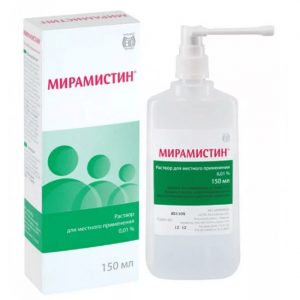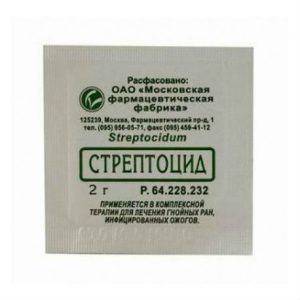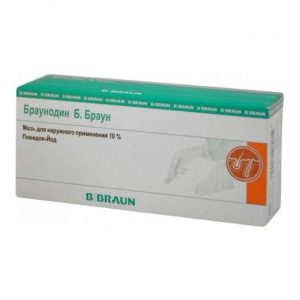Description
Latin name
MIRAMISTIN
Packaging
50 ml – polyethylene bottles (1) complete with a urological applicator – packs of cardboard.
Pharmacological action
Miramistin has a wide spectrum of antimicrobial activity, including hospital strains that are resistant to antibiotics.
The drug has a pronounced bactericidal effect against gram-positive (Staphylococcus spp., Streptococcus spp., Streptococcus pneumoniae and others), gram-negative (Pseudomonas aeruginosa, Escherichia coli, Klebsiella spp. and others), aerobic bacteria and ana and microbial associations, including hospital strains with antibiotic resistance.
Has antifungal effect on the ascomycetes of the genus Aspergillus and the genus Penicillium, yeast (Rhodotorula rubra, Torulopsis gabrata, etc.) and yeast-like fungi (Candida albicans, Candida tropicalis, Candida krusei, Pityrosporum orbiculare, Malassezia furfur, etc.), dermatophytes (Trichophyton rubrum, Trichophyton mentagrophytes, Trichophyton verrucosum, Trichophyton schoenleini, Trichophyton violacent, Epidermophyton Kaufman-Wolf, Epidermophyton floccosum, Microsporum gypseum, Microsporum canis and others pathogenic fungi, in the form of monocultures and microbial associations, including fungal microflora with resistance to chemotherapeutic drugs.
It has an antiviral effect, is active against complex viruses (herpes viruses, human immunodeficiency virus and others).
Miramistin acts on pathogens of sexually transmitted diseases (Chlamydia spp., Treponema spp., Trichomonas vaginalis, Neisseria gonorrhoeae and others).
Effectively prevents infection of wounds and burns. It activates the regeneration processes. It stimulates protective reactions at the site of application, by activating the absorbing and digesting functions of phagocytes, and potentiates the activity of the monocyte-macrophage system. It has a pronounced hyperosmolar activity, as a result of which it stops wound and perifocal inflammation, absorbs purulent exudate, contributing to the formation of a dry scab. Does not damage granulation and viable skin cells, does not inhibit edge epithelization.
Not locally irritating and allergenic.
Indications
For use in surgery, traumatology:
– prevention of suppuration and treatment of purulent wounds
– treatment of purulent-inflammatory processes of the musculoskeletal system.
For use in obstetrics, gynecology:
– prevention and treatment of suppuration of postpartum injuries, perineal and vaginal wounds, postpartum infections
– prevention and treatment of inflammatory diseases (vulvovaginitis, endometritis).
For use in combustiology:
– treatment of superficial and deep burns II and III A degree
– preparation of burn wounds for dermatoplasty.
For use in dermatology, venereology:
– treatment and prevention of pyoderma and dermatomycosis, candidiasis of the skin and mucous membranes, foot mycoses
– individual prevention of sexually transmitted diseases (including syphilis, gonorrhea, chlamydia, trichomoniasis, g , genital candidiasis).
For use in urology:
is a complex treatment of acute and chronic urethritis and urethroprostatitis of a specific (chlamydia, trichomoniasis, gonorrhea) and non-specific nature.
For use in dentistry:
– treatment and prevention of infectious and inflammatory diseases of the oral cavity: stomatitis, gingivitis, periodontitis,
periodontitis – hygienic treatment of removable dentures.
For use in otorhinolaryngology:
– comprehensive treatment of acute and chronic otitis media, sinusitis, tonsillitis, laryngitis
– comprehensive treatment of acute pharyngitis and / or exacerbation of chronic tonsillitis in children aged 3 to 14 years.
Contraindications
hypersensitivity to the components of the drug.
Use during pregnancy and lactation
Used in obstetrics as indicated.
Data on the safety of the drug during lactation (breastfeeding) were not provided.
Composition
1 l of a 5% solution contains:
Active ingredient: non-aqueous glucose 50.00 g (corresponding to glucose monohydrate 55.00 g)
Excipients: hydrochloric acid, water for injection.ldimethyl-myristoylamino-propylammonium chloride monohydrate 100 mg
Excipients: purified water – up to 1 l.
Dosage and administration of
Adults
When used in surgery, traumatology, combiology for prophylactic and therapeutic purposes, irrigate the surface of wounds and burns, loosely tampon wounds and fistulous passages, fix gauze swabs moistened with the drug. The treatment procedure is repeated 2-3 times / day for 3-5 days. A highly effective method of active drainage of wounds and cavities with a daily flow rate of up to 1 liter of the drug.
When used in obstetrics and gynecology to prevent postpartum infection, it is used in the form of vaginal irrigation before childbirth (5-7 days), in childbirth after each vaginal examination and in the postpartum period, 50 ml of the drug in the form of a tampon with an exposure of 2 hours for 5 days. During the delivery of women by cesarean section, the vagina is treated immediately before the operation, the uterine cavity and incision are made during the operation, and in the postoperative period, tampons moistened with the drug are inserted into the vagina with an exposure of 2 hours for 7 days. Treatment of inflammatory diseases is carried out by a course for 2 weeks by intravaginal administration of tampons with the drug, as well as by the method of drug electrophoresis.
For the prevention of sexually transmitted diseases, the drug is effective if it is used no later than 2 hours after sexual intercourse. Using the urological applicator, enter the contents of the vial into the urethra for 2-3 minutes: men (2-3 ml), women (1-2 ml) and the vagina (5-10 ml). To process the skin of the inner surfaces of the hips, pubis, genitals After the procedure, it is recommended not to urinate for 2 hours.
In the complex treatment of urethritis and urethroprostatitis, 2-3 ml of the drug is injected 1-2 times / day into the urethra, the course of treatment is 10 days.
With purulent sinusitis – during a puncture, the maxillary sinus is washed with a sufficient amount of the drug. Tonsillitis, pharyngitis and laryngitis are treated by rinsing the pharynx and / or irrigation using a spray nozzle 3-4 times by pressing 3-4 times / day. The amount of the drug for 1 rinse is 10-15 ml.
For stomatitis, gingivitis, periodontitis, it is recommended to rinse the oral cavity with 10-15 ml of the drug 3-4 times a day.
Children
In acute pharyngitis and / or exacerbation of chronic tonsillitis, the pharynx is irrigated using a spray nozzle. For children aged 3-6 years: by pressing the nozzle-nozzle once (3-5 ml per 1 irrigation), 3-4 times / day for children aged 7-14 years by double pressing (5-7 ml per irrigation), 3 -4 times / day for children over 14 years of age by 3-4 times pressing (10-15 ml per irrigation), 3-4 times / day. The duration of therapy is from 4 to 10 days, depending on the timing of the onset of remission.
Terms of use of the drug
The drug is ready for use.
How to use the packaging with the
spray nozzle 1. Remove the cap from the vial.
2. Remove the supplied spray nozzle from its protective packaging.
3. Attach the spray nozzle to the bottle.
4. Activate the spray nozzle by pressing again.
Side effects of
Local and not easy: 15 requires withdrawal of the drug.
Possible: allergic reactions.
Drug Interactions
With simultaneous use with antibiotics, an increase in their antibacterial and antifungal properties was noted.
Overdose
There is no data on the overdose of Miramistin.
Storage conditions
The product should be stored out of the reach of children at a temperature not exceeding 25 ° C.
Expiration date
Expiration date – 3 years.
Deystvuyushtee substance
benzyldimethyl 3- (miristoilamino) propilammoniy chloride monogidrat
Dosage form
topical solution
Prescribing
Prescribing
Prescribing to mothers, Adults, For pregnant, For children
Infamed, Russia




